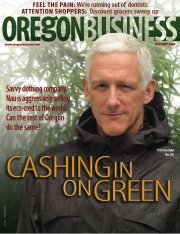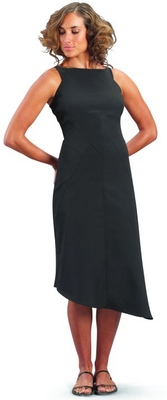In late 2004, the handful of people starting outdoor clothing company Nau faced a tossup. Founder Eric Reynolds, who started the legendary Marmot outdoor brand, wanted the company located in Boulder, Colo., where he lived. CEO Chris Van Dyke, a former Nike exec, wanted it in his hometown of Portland.
Portland clothing company Nau plans to build its future on social responsibility.
By Oakley Brooks
In late 2004, the handful of people starting outdoor clothing company Nau faced a tossup. Founder Eric Reynolds, who started the legendary Marmot outdoor brand, wanted the company located in Boulder, Colo., where he lived. CEO Chris Van Dyke, a former Nike exec, wanted it in his hometown of Portland. Van Dyke won out because he stood firm on two things: He wasn’t moving to Boulder, and as he puts it, “this is an Oregon company.”
Nau (pronounced “now”) is a bold venture looking to set a new standard for corporate citizenship in the high-profile apparel industry — an effort so concerted that even the Nau clothing color palette is chosen for longevity to prevent wastefulness. For that, “this is a better place,” Van Dyke says, sitting in Nau’s headquarters in Portland’s Pearl District. “There’s a thoughtfulness here. And as a brand, being from Oregon is a huge plus.” Indeed, the company’s image and the look of its clothing seems to be springing from the sophisticated-yet-outdoorsy culture that has come to define Portland. (It also hasn’t hurt that there’s plenty of creative apparel minds around town.) “The identity of the place is really something to be celebrated,” says Ian Yolles, Nau’s vice president of marketing.
As Nau prepares for an online launch this month of its gear (stores in Portland and three other cities will open later this spring), it also faces a common challenge with Oregon: trying to communicate and maintain its competitive edge in a global marketplace increasingly awash in ideas of environmental sustainability and corporate responsibility.
Nau has built the company with one of the greenest foundations anywhere. Its products will be made of ecologically benign materials, its compact stores and Web-reliant sales model are designed to cut energy use, and its giving program is exceedingly generous from the get-go. Nau’s plan and its all-star cast of execs — with loads of experience at Nike, Patagonia and other brands — have piqued the interest of investors who’ve contributed $24 million in venture capital so far.
But whether or not it reaches its five-year goal of 150 stores and $250 million in sales will depend on how well it communicates its eco-edge to the marketplace. There already is at least one established brand — Patagonia — with impeccable green credentials, and several of the biggies, including Nike and Adidas, are putting significant resources behind green products. For the same reason that Nau’s timing is good — many consumers are looking for corporate integrity — the startup also is likely to see pressure from competing brands that have far more cash and marketing muscle to compete with Nau for the same conscious customers.
“Globally, sustainability is hot right now,” says Peter Kim, senior analyst with Forrester Research in Cambridge, Mass., and a former Puma marketing executive. “The guys and gals at Nau will have to continue to keep an eye on their competitive advantage.”
GREEN PIECE |
IF A STARTUP’S FUTURE SUCCESS were based solely on a management team’s experience, Nau would seem headed for the stratosphere. Soon after Reynolds (who’s since left Nau) talked to Van Dyke about the company idea in mid-2004, Van Dyke assembled a seasoned group of eight interested folks drawn from his days as a top marketing executive at Nike and Patagonia.
Among them was Yolles, who also directed marketing at Nike and Patagonia; Mark Galbraith, who was instrumental in the development of Polartec fleece at Malden Mills before designing products at Lowe USA and Patagonia; and Jil Zilligen, who ran Patagonia’s 1% for the Planet corporate philanthropy program and eventually spun it off as a separate nonprofit.
“We were sitting around my living room saying ‘If you do it, I’ll do it,’” Van Dyke says. He later recruited Steven Gomez, former Nike global brand president, as Nau’s board chair. In addition to facing the unknowns of a startup, they were wrestling with conflicting realities: The world didn’t need another clothing company, but the clothing world did need some serious reform. In the end, Van Dyke says, they decided only a company built from scratch could drive that reform.
“There’s this new activism going on — that in business and technology, we are going to find the solutions to today’s problems,” says Van Dyke, who ran a sustainability consulting company with Zilligen before jumping to Nau. “Instead of chaining yourself to a tree, I’d like us to find a business reason to not cut it down.”
A key element of the Nau business model is the eco-credentials of its clothing line. The company developed 30 new materials with suppliers including polylactic acid, a corn-based compound that will substitute for nylon and polyester, two petroleum-based clothing staples that didn’t meet Galbraith’s no-new-oil standard for Nau materials. The company also worked with garment industry collective Organic Exchange to source organic cotton with longer fiber lengths to allow use in higher-end clothing.
“We had a lot of personal relationships with suppliers to draw on and they’ve been willing to assume some risk with new materials,” says Zilligen. (Nau has also promised to have its contract factories across Asia and around the world audited by third parties.) “Some suppliers also recognize there’s a wider market out there for these goods.”
In the company’s 2,000-square-foot “webfront” stores, to be built to LEED building standards, customers will be asked to size up and try on the company’s sleek hybrid line of outdoor and casual wear. Nau will offer a 10% discount if customers use computer terminals in the store or at home to purchase the item and have it sent from a Portland warehouse to the customer’s home. Bypassing independent retailers and selling directly to consumers improves Nau’s sales margins significantly over traditional wholesale clothing brands. Central distribution and Web sales also allow Nau to save the energy and transportation costs associated with constantly stocking stores with new inventory. But Van Dyke admits a lot of uncertainty about how customers will take to the new process and says the first stores will carry extra inventory to accommodate traditional buying habits. “After a year, we think 30% of people will take the discount and buy online but I’m not even convinced of that. We’ll see.”
After each purchase, customers will be asked to direct a cash gift by the company — 5% of their purchase price — to one of 12 local and nonprofits. The “crown jewel” of the Nau corporate responsibility plan, as Van Dyke coins it, would put the company in the top 50 of corporate givers worldwide if it hits its sales goals in five years.
NAU’S MARKETING TEAM ALSO SPENT SIGNIFICANT ENERGY THIS FALL projecting an unvarnished yet lofty image of the company on its website. Employees and friends mix blog entries and short movies about hip-hop dance classes and river-wave surfing with discussions about individual and corporate sustainability. Nau’s home city is also a recurring theme on the blog’s “Reasons to Love Portland” series.
The whole effort is a very deliberate attempt to establish the company’s authenticity before anything goes up for sale on the site. Company officials say they also plan to keep a forum for ideas free of sales promotions after the new line launches.
“It’s really important that we establish a conversation that’s based on ideas and a relationship with people that’s not about the product,” says Hal Arneson, Nau’s creative services director, who produced Patagonia’s catalog for two decades. “We dislike people who use their blog to push their shit.”
That authenticity may prove to be Nau’s biggest differentiator, especially since several analysts agree that it’s only a matter of time before other companies incorporate some of Nau’s new materials and elements of its sales and distribution model. (Nike already has its green Considered line on the market.) Indeed, in the spirit of corporate responsibility, Nau has told suppliers to share the new clothing materials with competing brands and has offered up royalty-free the software driving its corporate giving program.
“The challenge is there’s a lot of clamor out there,” says Michael Hodgson, president of SNews, a specialty retail industry newsletter. “Nau has a new retail package — it’s outdoor oriented but very urban influenced. The question is can they convey their message to the point that enough customers hear it?”
Hodgson, a longtime outdoor apparel industry observer, says Nau is making all the right moves to establish an authentic brand so far — including sharing its materials with other brands. “If anybody can pull this off,” he says, “it’s this group.”
Have an opinion? E-mail [email protected]



